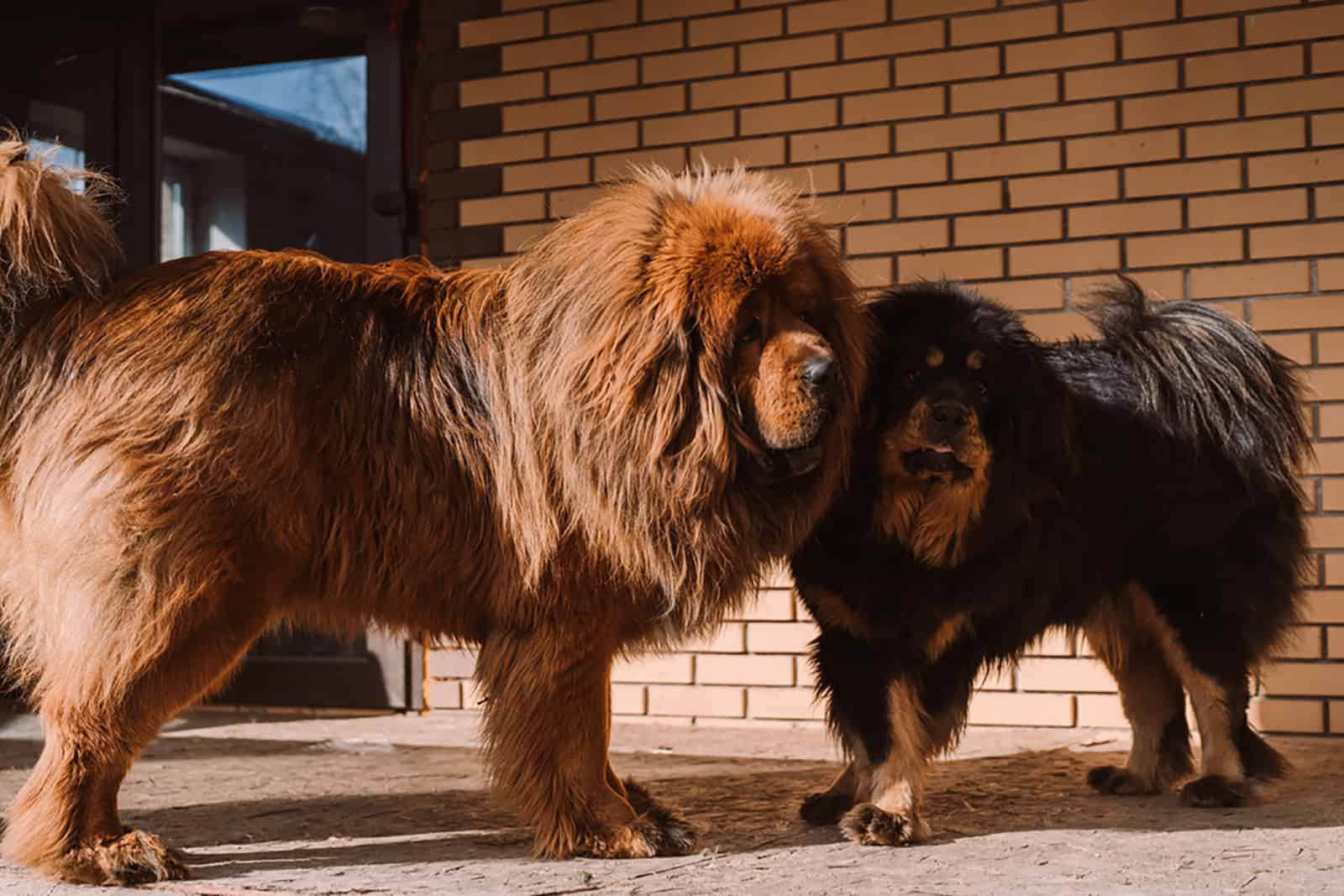Tibetan Mastiff puppies that are soft and cuddly develop into powerful, tenacious, large canines that resemble lions or even Tibetan bears.
The origins of this large breed are a little obscure, but we do know that they were developed in the Himalayas, or more specifically, in Tibet, a long time ago in order to guard livestock, monasteries, and palaces.
The breed is considered to be the common ancestor of contemporary mastiff breeds.
Since they are so big, having a Tibetan Mastiff growth chart is a great way to get an idea of their size and weight, particularly through different stages of their development.
Mastiff puppies are very different from adult Mastiffs, and that difference is reflected in their physical size and appearance.
Through years of careful breeding, the Tibetan mastiff has lost some of its original features, while developing new coat colors and becoming heavier.
This breed is intelligent but stubborn, which means that they can get moody and adopt new skills only when they feel like it.
Without further ado, let’s move on to the Tibetan Mastiff growth chart and see how the weight of these puppies changes throughout the first couple of years of their lives.
Tibetan Mastiff Growth Chart
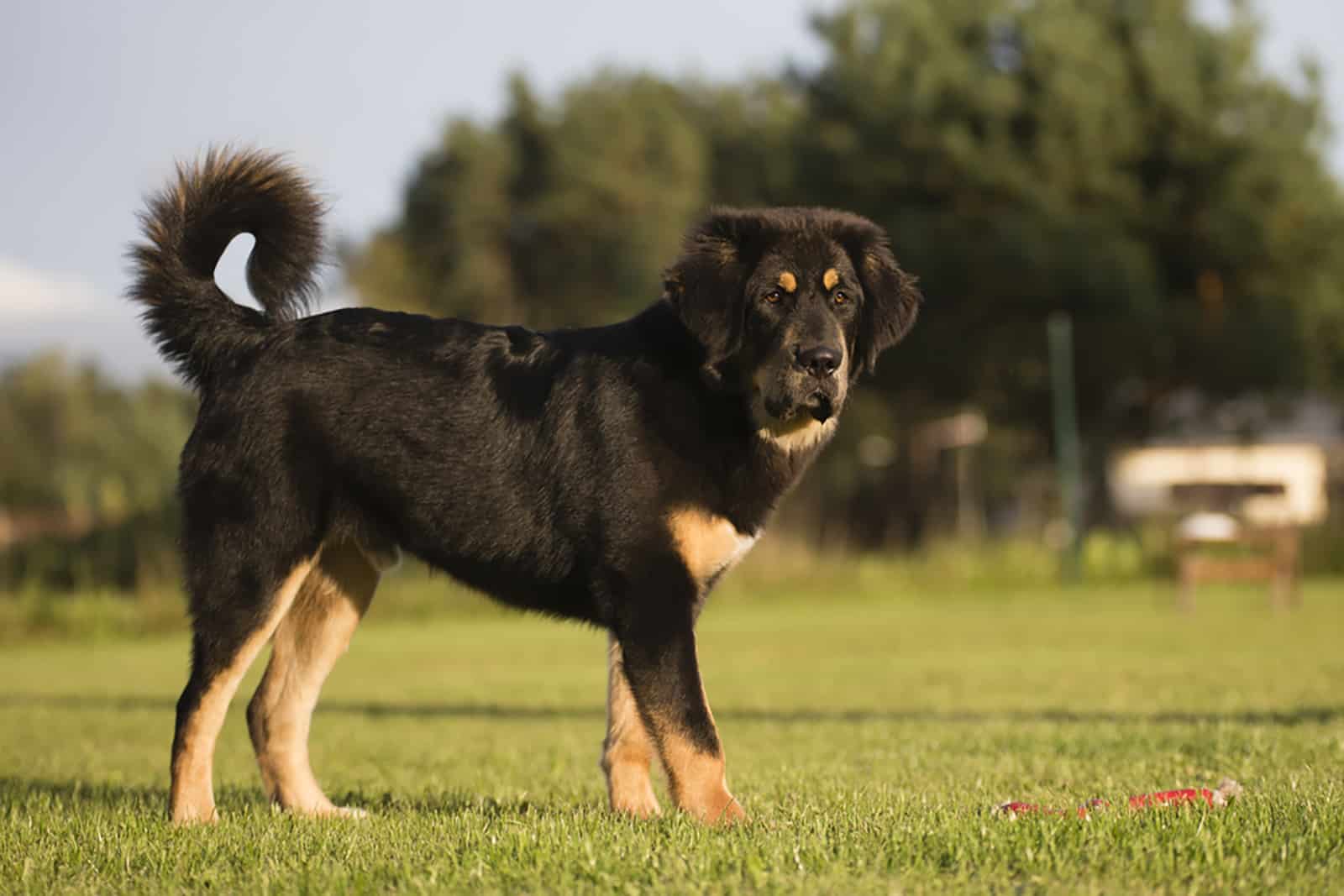
[table id=621 /]
Why Do I Need A Tibetan Mastiff Growth Chart?
One of the most important aspects of dog ownership is monitoring a puppy’s development throughout those crucial early months. That’s possibly even more true for a dog breed as large as the Tibetan Mastiff.
You might be surprised by how much space, activity, and food they actually require.
Using our Tibetan Mastiff growth chart, you can monitor your puppy’s development and ensure that its growth and weight are moving in the appropriate direction.
It’s simple to check the chart against your pup’s real weight and size on a frequent basis to make sure there are no deviations.
The Tibetan Mastiff growth chart brings you more than just that, though.
You may use this information to plan your Mastiff’s nutrition, living area, as well as your budget, by knowing how big and heavy it should be at any given age.
Large dogs naturally consume a lot of dog food, but you should focus more on quality than quantity. If they are active and experience a lot of physical stimulation, they require a nutritious diet of high-quality foods.
A dog is not exactly an inexpensive pet. A Tibetan Mastiff puppy costs between $1,500 and $6,000 on average on its own, so anything that can help you save money in the long term and budget your spending more effectively is a must-have item.
When Do Tibetan Mastiffs Stop Growing?
Tibetan Mastiffs take longer than most dog breeds to achieve their full size because they are such a large dog breed. Most Tibetan Mastiff puppies, both male and female, need up to 18 months to attain their full size.
The largest Tibetan Mastiffs, however, might continue to bulk up and add muscle for another six months or more.
How Big Do Tibetan Mastiffs Get?
Your Tibetan Mastiff’s size can be predicted in three different ways: by taking a look at the parents, the paw size, or by having it take a DNA test.
You can estimate the size of your puppy by observing the size of its parents.
If you purchased your Tibetan Mastiff from a breeder, request information on the parents’ and prior litters’ sizes so you can estimate the size of your puppy when it is an adult.
Examining your puppy’s paw size is another approach to estimating its size.
If they appear disproportionately large in comparison to their legs and body, they are still growing; however, if they appear proportionate to the body, your puppy has attained adult size.
Finally, if you don’t have access to the parents’ information, you can perform a DNA test and use the results to estimate your Tibetan Mastiff’s adult size.
According to the American Kennel Club, a male Tibetan Mastiff is typically between 90 and 150 pounds and 26 to 29 inches tall.
A female Tibetan Mastiff, on the other hand, stands between 24 and 27 inches tall and weighs between 70 and 120 pounds.
To put these numbers into perspective, we can compare the Tibetan Mastiff size to some other well-known dog breeds. For example, adult Great Danes range from 100 to 120 pounds, German Shepherds “only” go up to 9 pounds, and Labrador
Retrievers are even smaller, with their maximum weight being around 80 pounds.
Even Pitbulls, who are often considered to be stocky and large, are only half the weight of an average adult Tibetan Mastiff.
That really gives you a great idea of how massive this breed truly is.
Tibetan Mastiff Development And Growth Stages
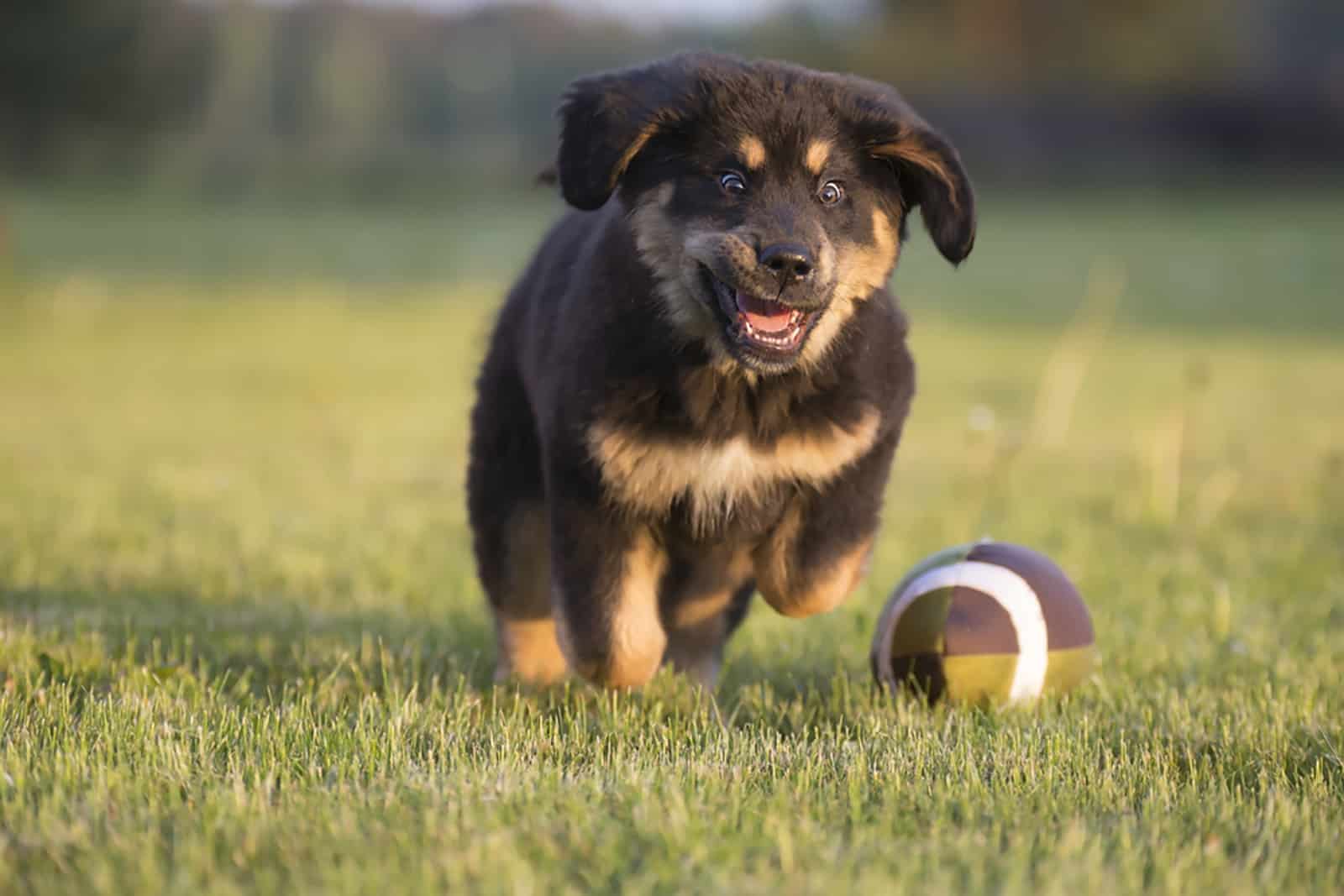
When you need a simple overview of your dog’s predicted size and weight range, the Tibetan Mastiff puppy growth chart is excellent. But what if you want even more information?
Then continue reading because we have some wonderful information about each of the significant growth phases that occur during a Mastiff puppy’s development.
In essence, the first eighteen months of its life can be broken down into various growth periods. Each of those stages guides the puppy through several mental and physical developmental milestones.
The individual timelines will not always exactly follow this pattern because every single puppy is unique, but it still serves as an excellent starting point for any dog owner who wants to put the development of their Mastiff into perspective.
From Birth To Two Weeks
This is the neonatal or newborn stage. Due to the puppy’s closed eyelids and undeveloped ears, it is completely blind and deaf at this point. It spends the majority of its time sleeping because of this.
The mother does most of the work during this phase, including cleaning the puppy and keeping it warm because it’s still unable to control its body temperature. The puppy receives its nutrients from the mother’s milk.
From Two Weeks To Four Weeks
The puppy’s ears and eyes open at three weeks, and at that point, it begins to show curiosity and awareness of its surroundings and fellow puppies.
The puppy’s first teeth break through at four weeks of age, at which point the breeder can start feeding it some solid puppy food for the first time.
But remember, whether you choose a diet of commercial dog food, home-cooked meals, or raw food, just make sure that quality is the number one priority.
From Four Weeks To Three Months
The puppy can be taken away from its mother at eight weeks because it should have finished weaning off by then and become entirely dependent on puppy food for sustenance. At this point, housetraining should be implemented along with socializing and training.
You can begin gradually exercising with the puppy at three months old to help it maintain a healthy weight. Inquire with your veterinarian about vaccinating and deworming your puppy.
From Three Months To Nine Months
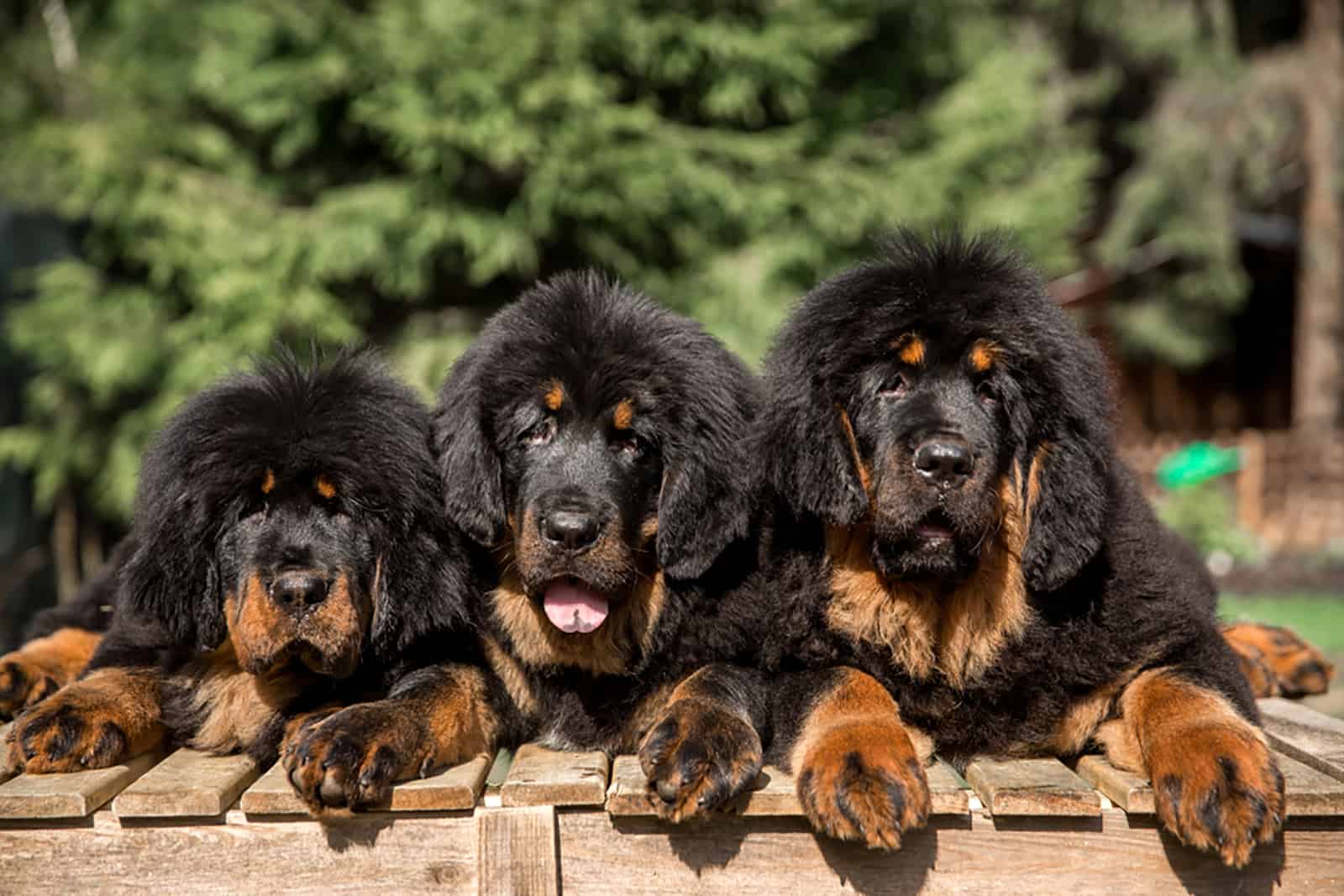
The puppy starts to exhibit greater stubbornness, territoriality, and disobedience during this teenage era.
More socialization and training are therefore essential at this period to make sure the puppy understands its place in relation to the other family members because it can sometimes try to assert its dominance.
You will need to pay much more attention to your puppy during this time.
During this time, your puppy starts chewing and will want to nibble everything that catches its eye. This is happening because the permanent teeth are beginning to form.
The puppy will exhibit signs of fear as well, so you should offer your support and dependability during this stage so that you can build a relationship of trust with your puppy.
From Nine Months To Eighteen Months
In this stage, your Tibetan Mastiff will start displaying the temperamental traits that are unique to this breed. It should be a textbook example of a calm, friendly, and obedient dog.
As your dog enters adulthood at this time, you should convert them from puppy food to adult food. To prevent disturbing your puppy’s stomach and resulting in vomiting or diarrhea, the process should be carried out gently, step by step.
Speaking of diarrhea, have you given any thought to puppy diapers?
This is the age at which your Tibetan Mastiff typically becomes sexually mature. Therefore, if you do not intend to breed them, you should talk to your veterinarian about spaying or neutering them.
Fully Adult Tibetan Mastiff
Tibetan Mastiffs are regarded as being sexually, physically, and mentally mature as adults.
At the age of 18 months to two years, most Tibetan Mastiffs usually reach their adult dog weight and height, but some can take up to five years to reach full maturity.
At this point, you should feed your pooch a good, balanced diet and engage them in a lot of physical activity in order to promote healthy development and long, fulfilling life.
Factors That Affect Tibetan Mastiff Growth
The final size of any dog is influenced by a variety of factors. Although all Tibetan Mastiffs are giant dogs, there are variances from one individual dog to another.
Some of them are heavier and bigger than others, and this is due to two different sets of factors: internal and external.
Internal Factors
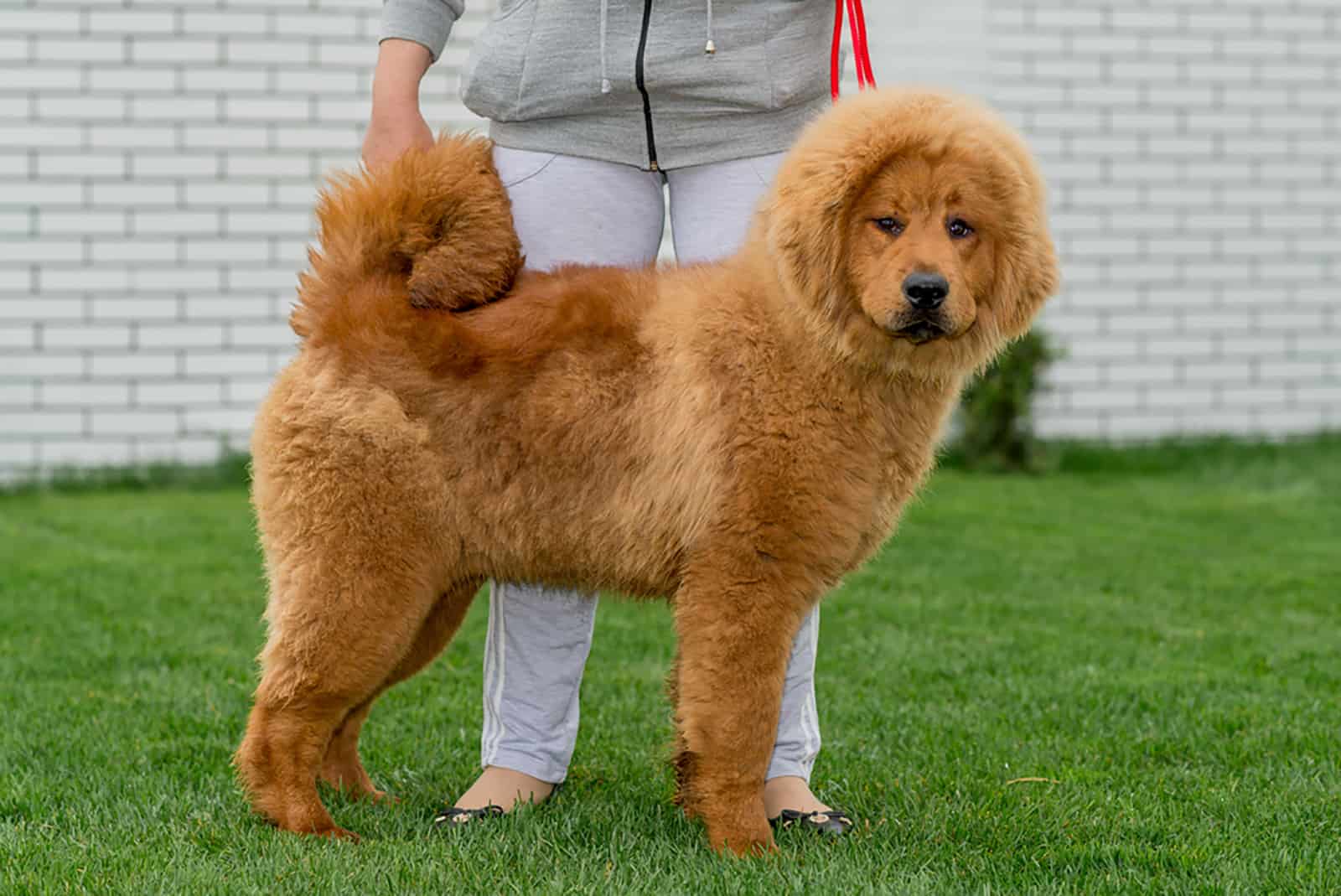
Any Tibetan Mastiff, and every other dog for that matter, is born with certain internal characteristics. These factors are beyond your control and you can’t really influence them in any meaningful way.
Although you can’t actually change a dog’s gender or genetics, being aware of certain information about it can help you prepare for what’s to come and ensure that the puppy has the ideal environment in which to grow.
Genetics
The size of your Tibetan Mastiff’s parents is the key determinant of its size. The size will resemble that of the parents almost exactly.
You can probably assume that your Mastiff will be larger than average if both of its parents were exceptionally enormous. The same holds true for puppies whose parents are smaller.
The size of the puppies will typically fall somewhere in the middle if the two parents had a big size difference, such as if the male was quite huge and the mother was on the smaller side.
Naturally, there isn’t a rigid rule or a precise mathematical formula that will enable you to determine your dog’s exact height and weight, but following these recommendations will provide you with a good general idea.
The weight chart at the start of the article uses weight ranges rather than single weight values for that exact reason. You should always allow for some wiggle room in your planning.
Health
This factor is closely tied to genetics. The genes that the puppy inherits from its parents will not only be related directly to size, but they can also be carrying certain congenital medical conditions.
Some conditions can stunt a puppy’s growth and therefore result in a dog that isn’t as large, as fit, or as healthy as it’s supposed to be.
It’s vital that you get a detailed response from the breeder about the puppy’s health background before you actually buy it and bring it home.
We’ll go through some of the more common related health problems later on in the article.
Gender
Tibetan Mastiff males generally grow and develop more quickly than females.
These different growth rates start to manifest very early in the development of the puppies. Male puppies will begin to outgrow their female counterparts in terms of height and weight even at the age of five or six weeks.
When they reach full maturity, the disparity can widen to anything from two to five inches in height and 20 to 70 pounds in weight.
External Factors
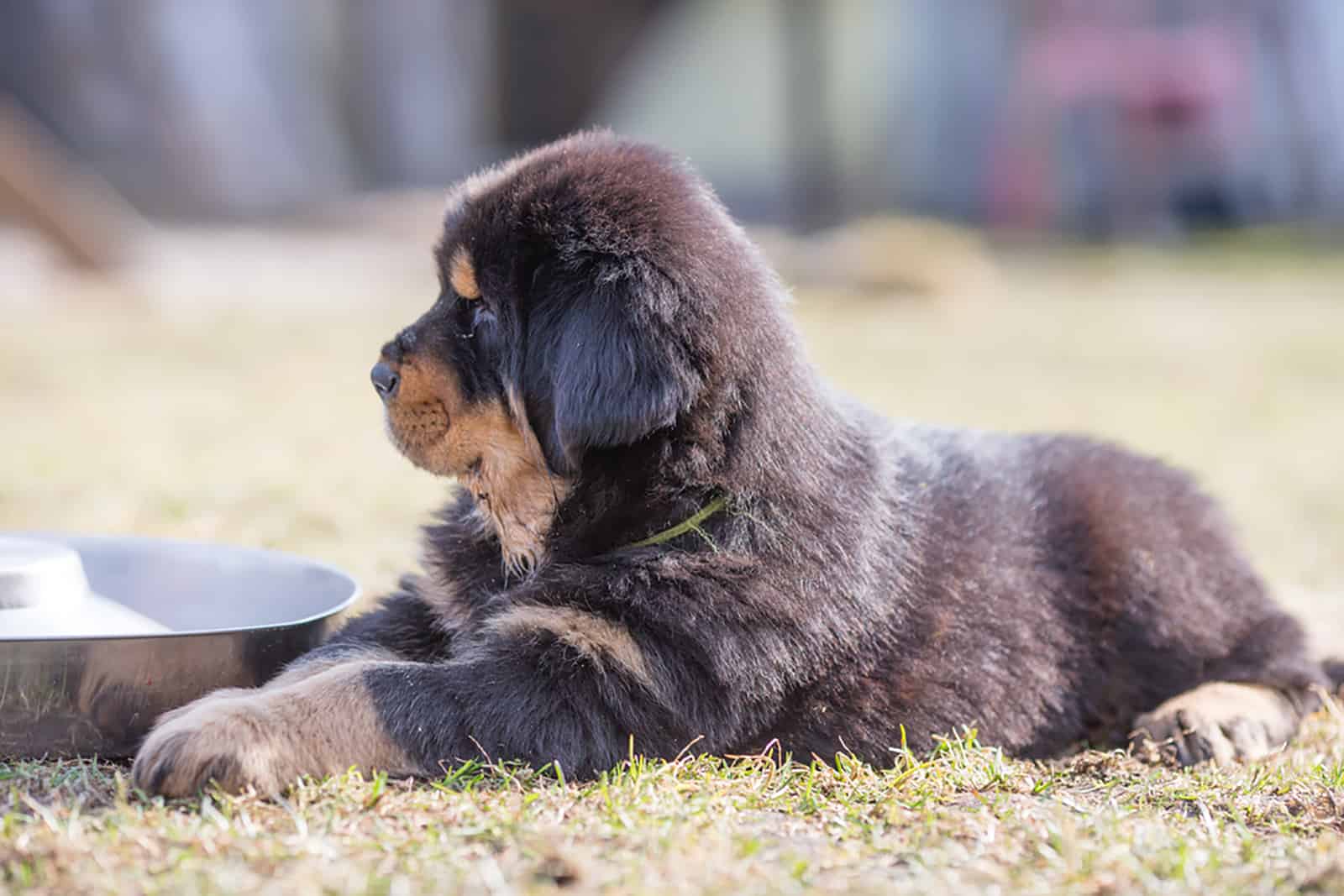
The consequences of a dog’s environment are considered to be external influences on its weight. These are the things that you have control over, such as how much food you give and how much exercise you encourage.
Your Tibetan Mastiff’s weight can be managed and kept under control with the help of nutrition and exercise. If you’re not taking any action to keep your dog inside the healthy ranges, having a weight chart is useless.
You can do this by giving it a quality, protein-rich diet and lots of stimulating exercise.
Here are some more details about that.
Food
For a Tibetan Mastiff to have a longer, healthier life, adequate nutrition is essential. A Tibetan Mastiff breed in good condition can live for 10 to 12 years.
Obesity or being overweight can appear in your dog as a result of eating a poor diet or eating too much. A balanced, nutrient-rich food will support your puppy’s growth and development in a positive and healthy way.
Steer clear of cheap, low-quality dog food brands.
To make sure you are on the right track with your dog’s food, you can always talk to your veterinarian.
Exercise
You should engage your Tibetan Mastiff in some moderate exercise and physical activity to keep them in top physical condition.
While they normally dislike playing games, Tibetan mastiffs adore taking long walks and soaking up the sights around them.
To keep them from becoming too territorial, try to alter the path that you take as frequently as you can. This will prevent their guard dog instincts to kick in, and also be more interesting and less monotonous for both the dog and yourself.
They need to exercise for around sixty minutes every day. This will help to keep their weight stable and their body in good shape, but you need to make sure not to overwork your puppy, though.
Does Spaying/Neutering Affect Tibetan Mastiff Growth?
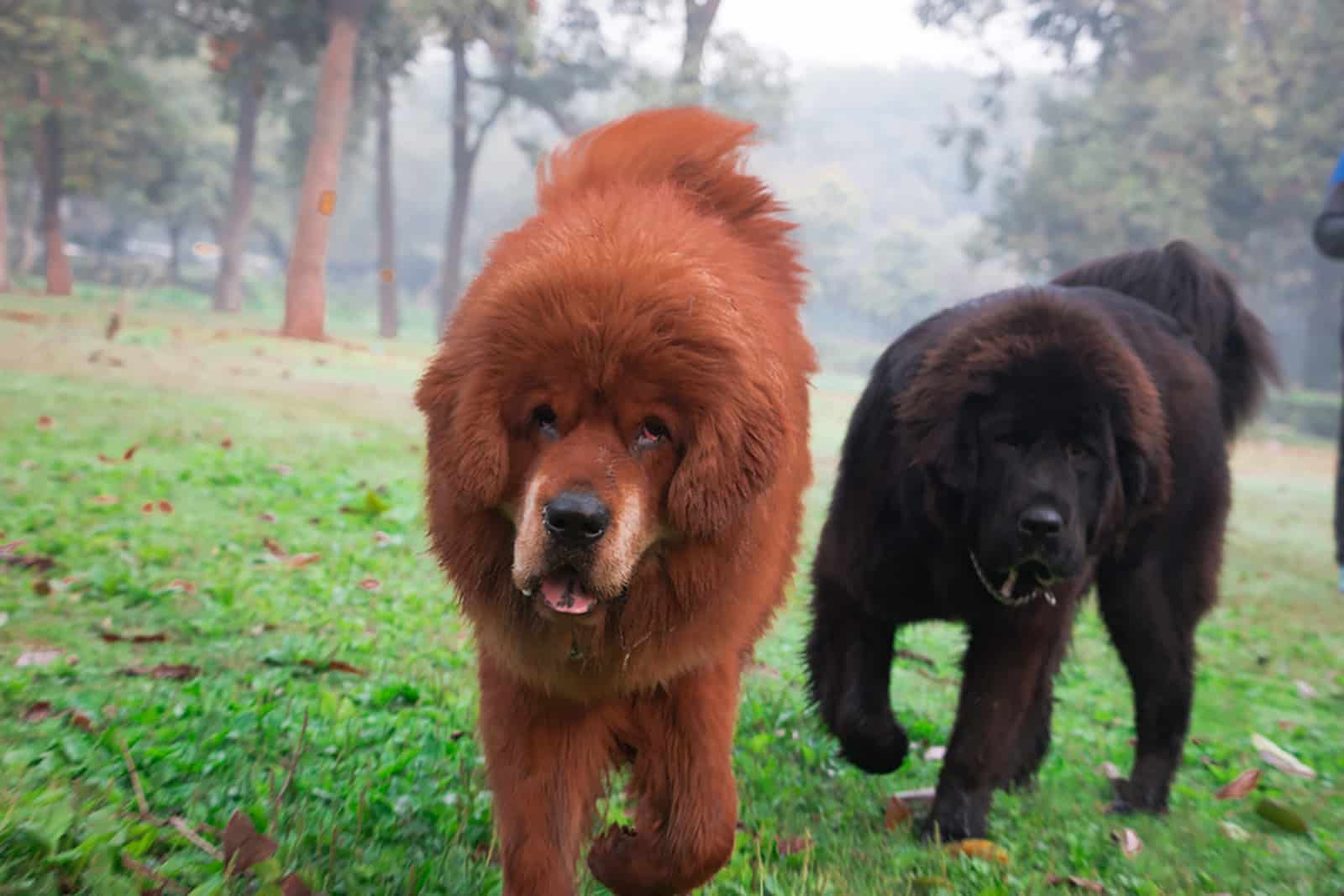
Ovaries, fallopian tubes, and testicles are surgically removed during spaying and neutering, two procedures that can be performed on all dogs, depending on their gender.
Up until the age of 18 months or even two years, you should probably not put your Tibetan Mastiff through this procedure as it might interfere with its sexual development.
This is due to the fact that hormones control the growth plates, and if they are removed before your Tibetan Mastiff has finished growing, they may develop different bone, joint, and growth problems as well as weight problems.
Of course, spaying or neutering your Tibetan Mastiff has its advantages.
Health issues such as pyometra, breast tumors, uterine tumors, and perianal fistulas are among the risks that are significantly decreased by spaying a female Mastiff.
Read next: Infected Dog Spay Incision Healing Process: What Happens After Spay Surgery?
Neutering, on the other hand, may lower the chances of your male Mastiff developing potentially fatal diabetes, prostate problems, and testicular cancer.
Is My Tibetan Mastiff Overweight Or Underweight?
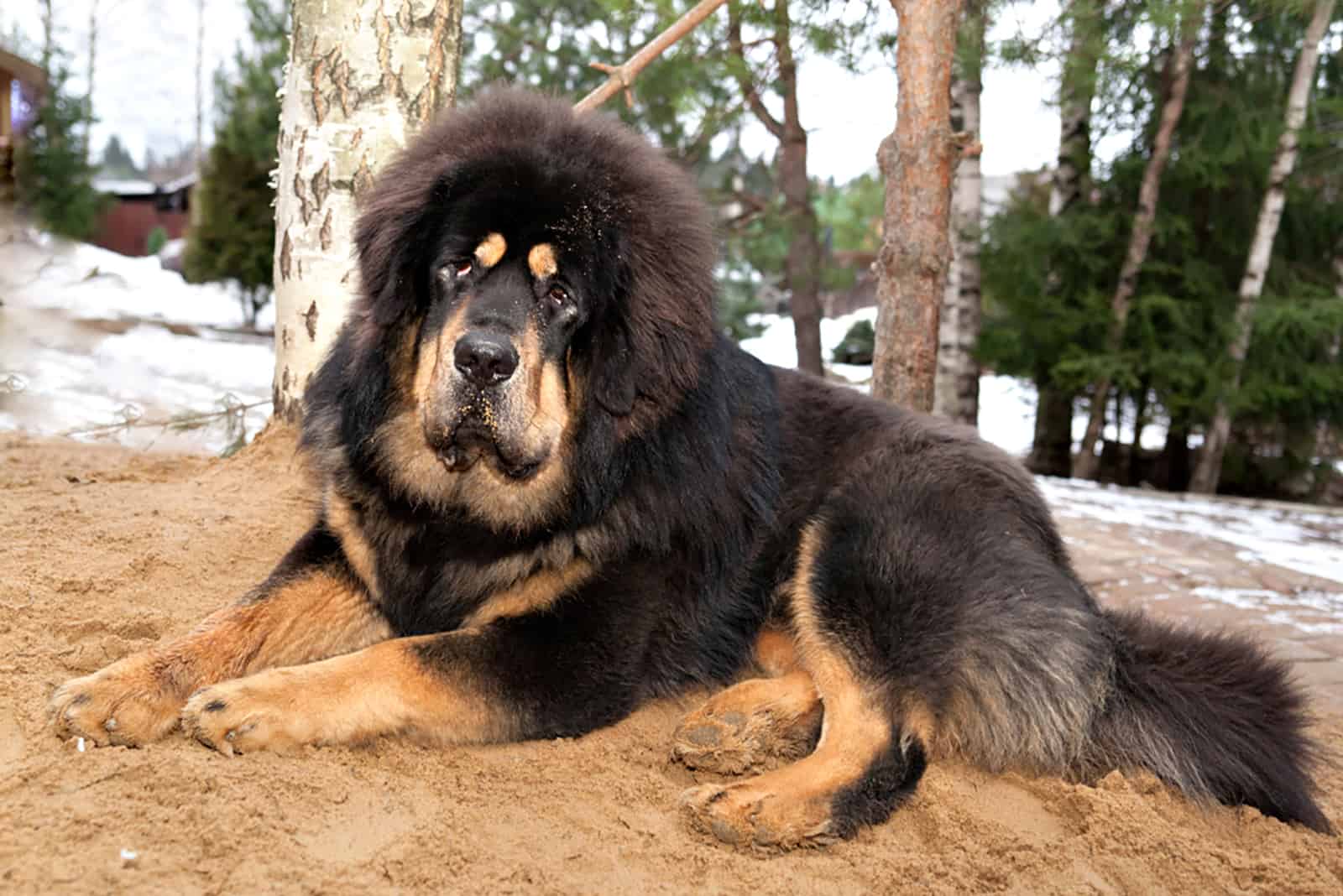
To be healthy, Tibetan Mastiffs need to eat properly. Puppies who are underweight or overweight are more likely to develop health issues that could be fatal.
However, it can sometimes be tough to figure out if your Mastiff is in the correct weight range. It’s not really something that you can spot just by looking at it, especially because their fur can often obscure their actual figure.
So if you don’t have access to a scale, you need to think of alternative methods. Or actually, you don’t, we’ve thought of some for you.
Check Its Waist
The waistline and waist indentation of a Tibetan Mastiff says a lot about its weight and fitness.
If your dog has a typical hourglass figure, that is a good sign. Furthermore, if its waist is readily visible, that means that the weight is probably within a healthy range.
Feel The Ribs
This is a great test to check the weight of any dog, but it’s particularly useful if you have a Tibetan Mastiff, because they have a long, thick coat, unlike some of their cousins, like the English Mastiff or the Rottweiler.
Run your open palm across its ribcage and pay attention to what you feel. If there is a relatively thin layer of fat between the fur and the ribs, that’s perfect.
If the layer is too thick, then the doggy should probably shed a few pounds, and if you don’t feel any fat at all, it means that the diet is wrong and your dog is underweight.
Keep An Eye On The Energy Levels
Tibetan Mastiffs aren’t especially playful, but their working dog nature makes them excited for any exercises that feel work-related.
They won’t be able to keep going for hours at a high intensity, but they should be more than capable of showing short, but powerful, bursts of energy.
If it seems that the dog is unable to display these energy levels or it looks a bit lethargic, that could be a sign of a potential weight issue.
On the other hand, if the mastiff is alert and always up for a walk, that probably means that everything is okay.
What Should I Do If My Tibetan Mastiff Isn’t The Right Weight?
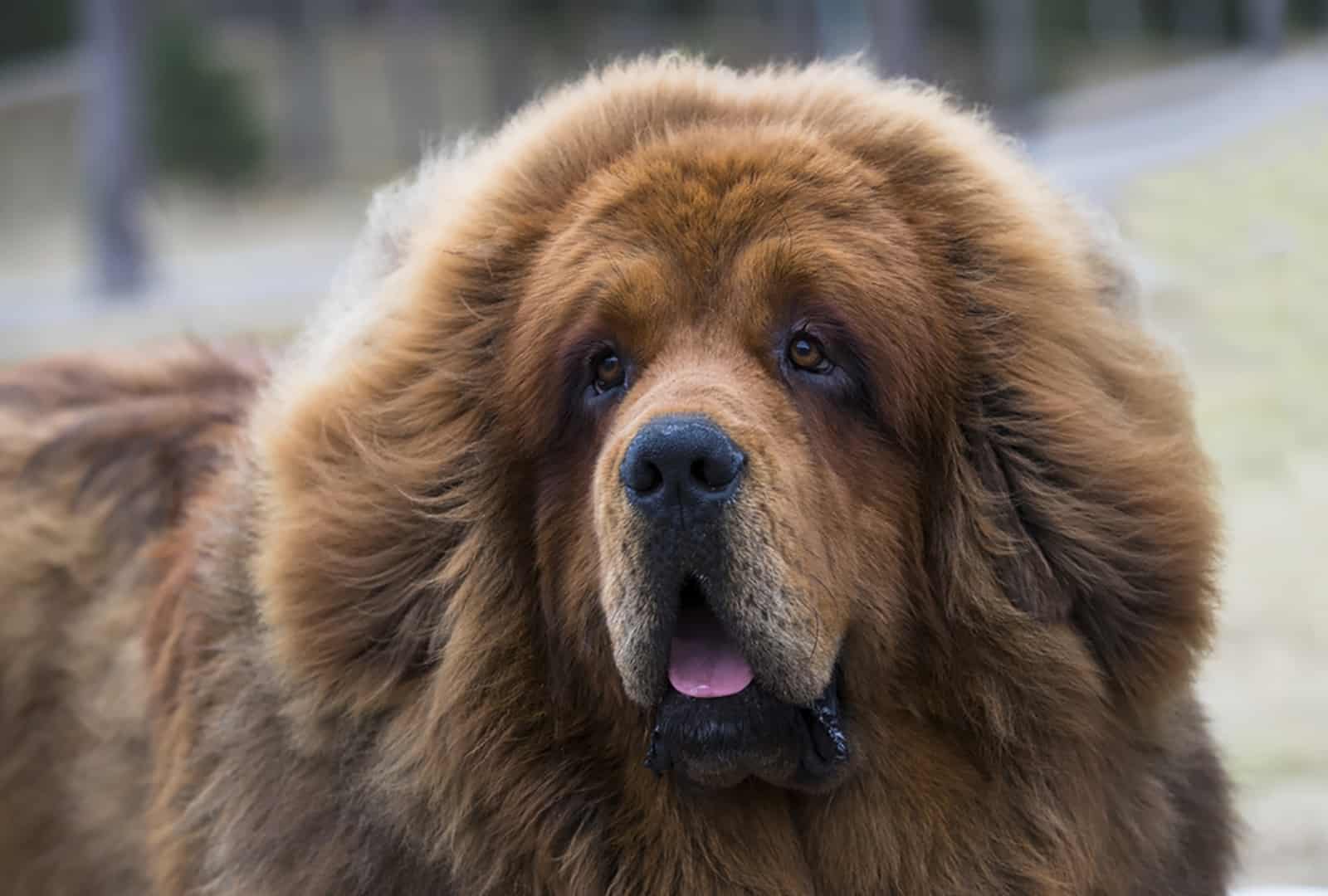
Maintaining a healthy weight is all about establishing routines and fostering good habits. If your Tibetan Mastiff is obese or underweight, that means that it probably fell victim to some bad habits.
They can be related to diet or nutrition, or they can be the symptom of a larger health issue. If it is indeed a question of health, then you should definitely reach out to your vet and see what can be done about it.
On the other hand, if it’s not a health issue, but rather the result of diet and/or exercise management, there are some things that you can do yourself to get your Mastiff back into good shape.
Switch Up The Diet
Give your dog food that is rich in nutrients, but not rich in fat. Proper nutrition will aid in maintaining your dog’s ideal weight.
As recommended by your veterinarian, feed your Tibetan Mastiff a premium diet.
Manage your dog’s meal size to control food intake. Only two cups of high-quality dog food are required every day for Tibetan Mastiffs. Instead of giving them their entire day’s amount of food at once, divide it up into smaller amounts.
Why not try making your dog some home-cooked meals? Food prepared at home is typically healthier than most of the stuff that you can find on the shelves of supermarkets and pet stores.
Use high-quality, healthy ingredients to prepare your Tibetan Mastiff’s food.
Try boiling some chicken for your Mastiff and see if it likes it.
Increase Or Decrease The Activity Levels
In addition to modifying your Tibetan Mastiff’s diet when it’s underweight or overweight, you should also make changes to the type of exercises that it takes, as well as the intensity.
Mastiffs are very fond of walking, so that is usually the preferred way of keeping them fit. However, if your Mastiff needs to lose some weight, consider taking longer hikes or increasing the intensity. Just make sure that you don’t overdo it.
Similarly, if your Mastiff needs to gain weight, then try to take shorter or less frequent walks until its weight is back to normal.
When taking them outside, especially during the heat, keep in mind that they have very dense double coats.
If you live in a hot climate, it’s better to avoid the warmest hours of the day by going outside in the early morning and late at night. Always keep an eye out for signs of heatstroke in your dog.
How Much Space Does My Tibetan Mastiff Need?
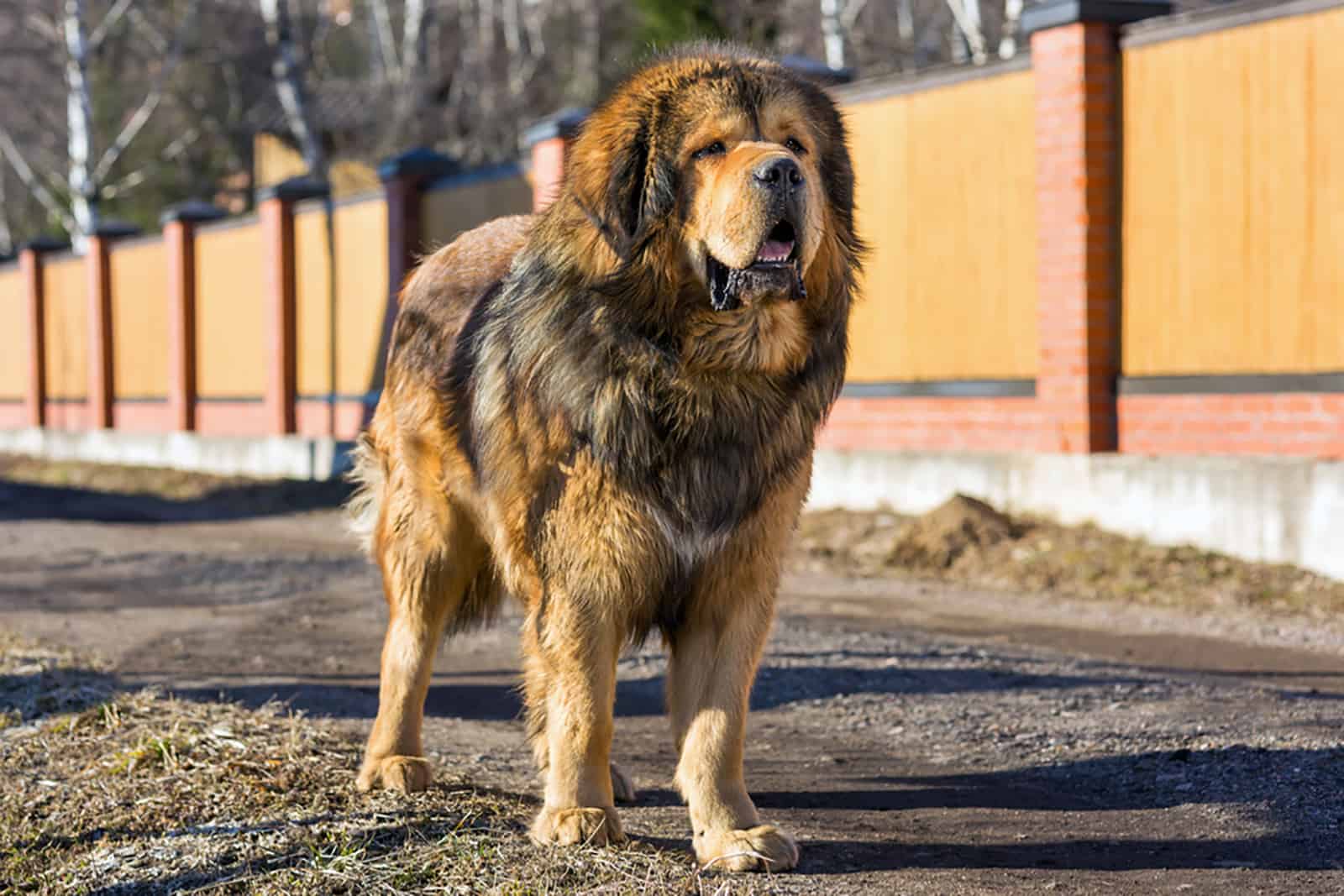
The Tibetan Mastiff needs plenty of room. They are low-energy dogs, but because of their size, they require a lot of wide, unrestricted space to wander around. They require a place to play and a place where they can stretch their legs.
As a result, homes with spacious yards are best suited for these big canines. Additionally, it is suggested and advised that these yards be enclosed by a sturdy fence that is at least 5 to 6 feet high.
This is due to the fact that these canines are territorial and must establish their borders from an early age.
In addition, this breed of dog takes a lot of attention; it is not the kind of dog you can leave outside by itself for an extended amount of time. In reality, this may lead to aggressive and harmful actions.
Although Tibetan Mastiffs can work hard and live outdoors, they need to be with their owners as often as possible.
They can only be left alone at home, for example, while you’re at work, if they have the necessary training.
To prevent them from feeling lonely and bored, it’s important to make sure they have either another dog’s company or that someone comes by to visit.
Tibetan Mastiff Health Problems Related To Weight And Growth
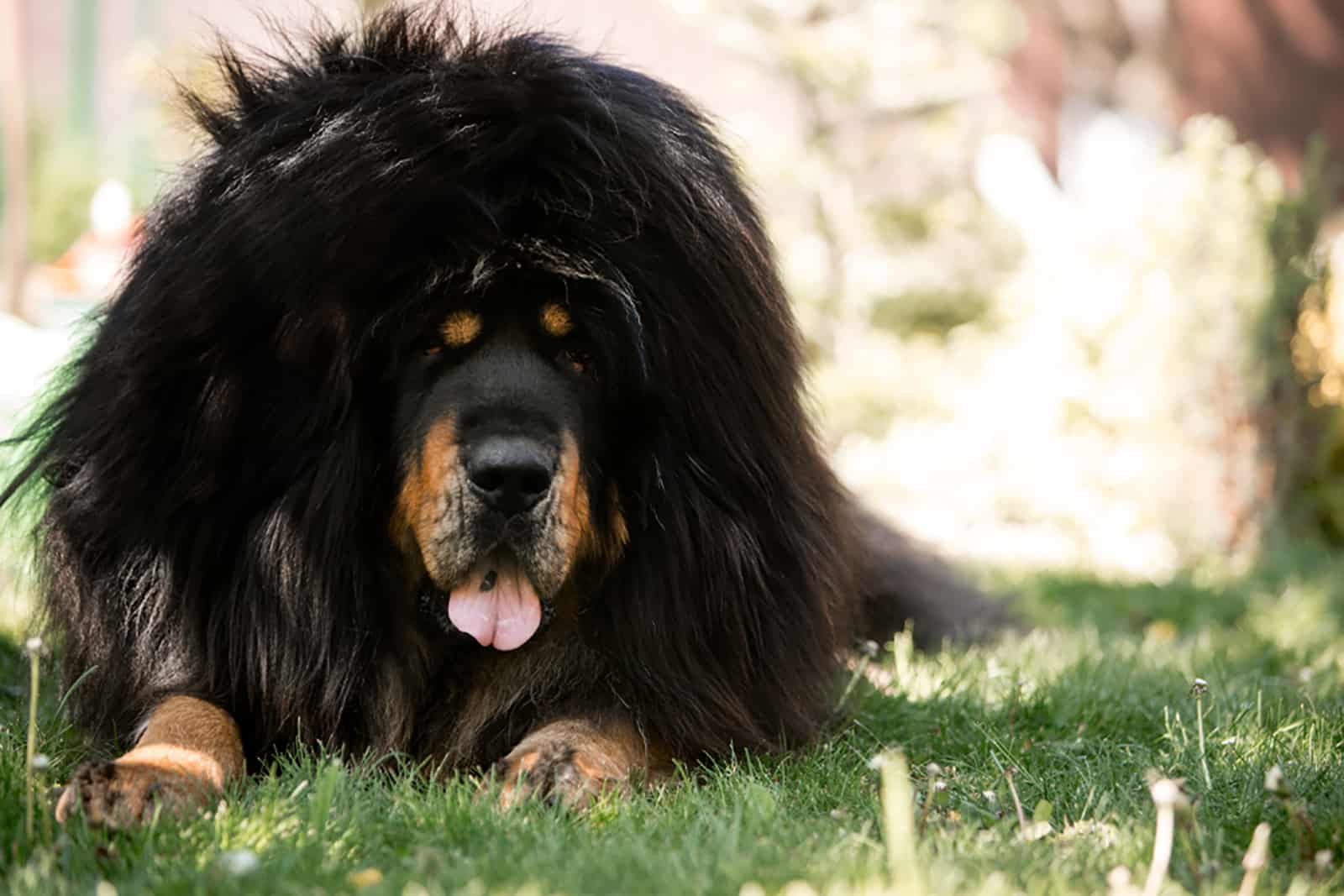
We’ve briefly spoken about the relationship between genetics, health, and growth earlier in the article. Now it’s time to delve a bit deeper into that topic and cover some of the most frequent illnesses and health conditions that affect Tibetan Mastiffs.
Generally speaking, the Tibetan Mastiff is a healthy breed with a relatively long lifespan, particularly for a giant breed.
However, there can be issues with certain parts of their body that cause them problems.
Hip Dysplasia And Elbow Dysplasia
Dysplasia is an extremely uncomfortable disorder where the joint is loose, and doesn’t fit properly with the bones, so the bones move around and cause pain to the dog.
It can happen in the hip joint or in the elbow joint, hence the two types called hip dysplasia and elbow dysplasia.
In contrast to dogs who had a limited weight gain due to restricted feeding, dysplasia is more common and more severe in dogs who experienced a rapid weight gain brought on by increased calorie intake.
Hypothyroidism
An underactive thyroid gland causes hypothyroidism, which leads to hormonal imbalance. Dogs with hypothyroidism may struggle with weight gain and have poor energy levels.
Sadly, hypothyroidism is incurable and dogs affected by it must be treated for life with thyroid hormone replacement therapy.
Obesity
Obesity is a disease that can increase the risk of joint issues, heart disease, back discomfort, and metabolic and digestive difficulties.
It is probably the health problem that is most obviously related to weight, and therefore it is quite clear what you can do to combat it. All the things that we previously mentioned as ways of keeping your Mastiff from becoming overweight apply here.
Obesity tends to be more common and more severe in small dogs, but not even giants such as Mastiffs are immune to it.
Final Thoughts
If you own one of these incredible large dogs, the Tibetan Mastiff growth chart is a great resource to have. It is something that can assist you in following the growth and development of your dog.
Using this weight chart, you can easily keep tabs on your Mastiff’s growth at any moment. You should just compare it to your dog’s real weight to see if there is a difference.
Planning a diet is considerably simpler when you are aware of your specific goals.
Not only that, but the growth chart can also direct your attention toward improving the health of your Tibetan Mastiff.
Sometimes being underweight or overweight can be a sign of a more serious health issue, and if you manage to notice it on time, you’ll have better chances of dealing with it successfully.
Check out:
13 Best Tibetan Mastiff Breeders In The U.S.
12 Tibetan Mastiff Colors That Will Definitely Break The Bank
